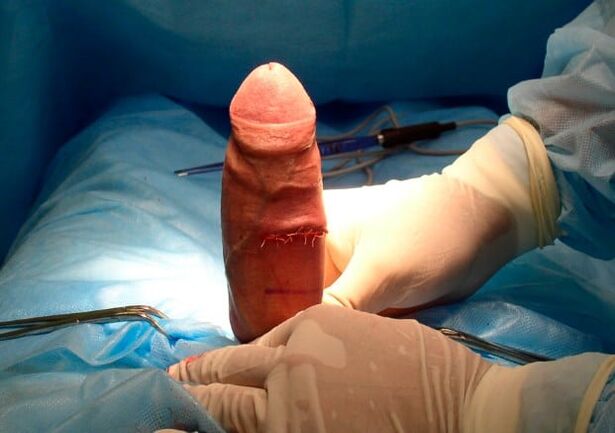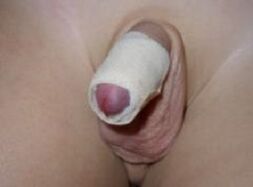The modern world offers many ways to help enlarge your penis. However, it is not their effectiveness that is confusing, but the length of time it takes to achieve the desired results.
For example, an expander must be worn for at least six months to achieve continuous growth, and the same can be said of a vacuum pump that must be used for three months.
The fastest option is a plastic penis enlargement, which can increase the penis not only in length but also in thickness. However, plastic surgery requires a significant financial investment, a long and painful rehabilitation period, and no one is insured against complications.
However, many members of the stronger sex are increasingly resorting to this method of enlargement, because the result remains for life. And with the choice of a competent clinic and a highly qualified surgeon, side effects can be prevented.
Due to the effectiveness and, most importantly, the popularity of such a procedure, it is necessary to learn how plastic growth occurs, how many centimeters the penis can grow, as well as to consider the indications and contraindications of the procedure.
Penile plastic surgery: indications and contraindications

Harmonious sexual intercourse plays an important role in a man's life. Therefore, special attention is paid to the size of the penis. Plastic surgery will help not only to enlarge the genitals, but also to correct functional disorders, the anatomical shape of the penis.
This type of surgery is performed in a variety of ways: from a medical point of view, it can be done for cosmetic purposes, or it can be a genital augmentation operation.
In most cases, men apply for penis enlargement or to correct the natural curvature of the penis.
Plastic surgery has its own indications for surgical intervention:
- Low potential as a result of vascular disorders, genital deformities, endocrine diseases.
- Erectile dysfunction in the presence of diabetes mellitus.
- Hypertrophic pathological changes in the tissues of the cavernous organs of the genital organ.
- Congenital abnormal development of the penis.
- Various mechanical damage to the penis.
- Surgery was performed on neighboring organs.
Indications include a desire to change sex or a desire to enlarge a man's genitals, because the modest size of the penis significantly impairs the quality of intimate life and leads to bed failures.
Plastic also has the following contraindications:
- Children under 18 years of age.
- Mental disorders.
- Diseases of the blood, impaired blood clotting.
- Chronic diseases, problems with the cardiovascular system, metabolic disorders and other common surgical contraindications.
- Diseases of the genitourinary system, sexually transmitted diseases.
- Acute infectious processes in the body.
While mental disorders are definitely the opposite, some diseases are relative. In some cases, your doctor may recommend that you visit other doctors to get appropriate treatment for your illness.
Once the body recovers and recovers from pathological conditions, these contraindications become insignificant and plastic growth is no longer possible.
Plastic: stages and essence of the procedure

If there are no serious symptoms for plastic surgery, but a man has a desire, the doctor prescribes a consultation with a psychologist. It is he who confirms that the man is sane and gives the appropriate permission to enlarge his penis in a plastic way.
As a rule, the doctor then acquaints the patient with the course of the procedure, tells some nuances and can present a photo before and after the corrective intervention.
Often the doctor can show not only a photo but also a video to demonstrate the process and prepare the patient. In addition, men undergo the necessary tests before plastic surgery at the clinic:
- Complete blood count, clotting reaction.
- Blood group, Rh factor.
- Blood glucose levels.
- Fluorography.
- General urinalysis.
- ECG.
If a man is over 60, he must have the opinion of a therapist who is considered safe for a particular patient. Plastic enlargement of the penis occurs as follows:
- The procedure is performed under general anesthesia.
- The man's groin and penis are treated with an antiseptic solution covered with a sterile cloth.
- In addition, the doctor "enters" the supporting ligaments of the penis through a certain incision, exciseing them in a special way, as a result of which the secret part of the body can be released.
- Then the internal ligaments are built a little higher, resulting in a longer penis.
The duration of the procedure varies from 1 to 3 hours. As a rule, it takes 1-1, 5 hours to increase the length of the penis, and more than 3 hours to increase the volume of the body.
It should also be noted that this procedure should be approached with special attention, paying attention not only to the price, but also to the clinics themselves, it is advisable to study the opinions of the stronger sex, read the recommendations.
It is advisable to dwell on the costs and say that it depends on many parameters: the equipment of the clinic, the specialty of the surgeon, additional medical services.
Some medical centers also include an extension of the cost of plastic surgery - an orthopedic device that is recommended to be worn after the intervention.
Although men are advised not to forget about local remedies that effectively combine the results after surgery.
Results of the operation

Although penis augmentation surgery is very common, popular, and helps many men, there is a risk of certain complications. All complications are conventionally divided into two categories:
- Natural complications as a result of surgery.
- Possible complications after surgery.
The first group includes bleeding that occurs in the early stages of penile healing, as well as at the beginning of the infection.
Typically, such complications can occur when the patient is in an inpatient setting and is properly corrected by a physician's operative response.
Potential complications include:
- The erection angle of the penis changes. That is, a member who was previously in an upright position "looked" to the right, then "looked" to the left after the intervention.
- Decreased sensitivity of the penis.
- The development of erectile dysfunction, as a result of which it is difficult to achieve an erection, the penis becomes soft during foreplay, which complicates sexual intercourse.
- Six months after surgery, the penis may become deformed. The condition can only be corrected with repeated surgery.
- Decreased potential.
- Death of penile tissue (if the thickness increases).
The above list of complications shows that genital mutilation surgery has its own pitfalls that must be considered before beginning this procedure.
But if the operation is already resolved, it is important to prepare for it: study the photo and video materials of the procedure, read all possible opinions of men about the chosen clinic, consult with several specialists to make the right choice, and make no mistake.


























